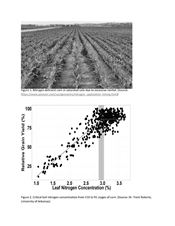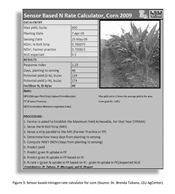In-Season Nitrogen Loss Assessment And Aftermath Management In Corn
DR. RASEL PARVEJ, BRENDA TUBANA, SYAM DODLA AND MATT FOSTER
BATON ROUGE, LA.
Phone calls are coming in regarding the nitrogen (N) losses from more than 10-inches of rainfall within 2-wks after sidedress N application in corn. Like this year, excessive rainfall often occurs in most years in the lower Mississippi Delta during the early growing season, resulting in saturated soils for several days, which accelerates N losses via denitrification, leaching, and/or runoff and reduces corn yield potential. Therefore, LSU AgCenter always recommends applying N at least in 2 splits for silt loam and clayey soils and 3 splits for sandy soils i.e., a small rate at planting (either by 2 by 2 or dribbling on the top of the bed), the rest around V6 stage (6 leaves with visible collars and plant is about 12 to 18-inch tall) as sidedress for silt loam and clayey soils, and/or another small amount before tasseling especially for sandy soils. For example, for a 220- bushel corn crop in silt loam soils, 220 lb N per acre should be split as about 30 to 50 lb at planting and 170 to 190 lb at V6 stage.
Applying a small rate of N at planting provides the corn plant enough N for setting maximum yield components at or after V6 stage. It also provides a wide window of opportunity to sidedress N application during the growing season from V6 to V8 stage. For instance, having at- planting N application would allow the producers to delay their sidedress application if missed at V6 stage due to rainfall and wet soil conditions. Although researchers from the mid-South states have showed that maximizing corn yield by a single N application during the growing season in both silt loam and clay soils is possible, for this to occur, the growing season must be ideal with moderate temperature and adequate and evenly distributed rainfall, which seldom occurs in Louisiana. Like this year, a single application is, therefore, a risky N management plan for corn production in most years in Louisiana.
Unfortunately, this year several corn producers applied their total N fertilizer in a single application as sidedress at or 1-3 weeks after corn emergence around V1-3 stages. After getting more than 10-inches of rainfall within 2-wks of sidedress, a significant amount of applied N may be lost during the early growing season before plant uptake since the root systems were very small at the time of application and were not even close to sidedress N fertilizer for active uptake. Most interestingly, all these rainfall events occurred during V1 to V4 stages, as typical in most years. If the producers had a small amount (30-50 lb) of N at planting as recommended, they could easily wait until V6-8 stages for sidedress application and be better off. At this stage, it is hard to measure how much N has been lost from our corn fields because N losses associated with excessive rainfall depend on several factors such as soil type, drainage, and cation exchange capacity (CEC). Although N can be lost via different loss mechanisms, N loss via denitrification is the main concern due to excessive rainfall especially in poorly drained soils but can occur in any soil with excessive rainfall that creates water-logged anaerobic conditions (Figure 1). However, denitrification loss of N should not be the major concern for well-drained corn field without water-logged conditions though leaching loss of N can still be a concern with high rainfall in well-drained soils. Leaching loss is also common in sandy soils with low CEC (<10). Good news is, N leaching00000 mainly occurs for nitrate- N (NO3-N) fertilizer. Since urea ammonium nitrate (UAN; 32-0-0, 30-0-0-2S, or 28-0-0-5S) is the most common N fertilizer for corn production in Louisiana, which contains only 25 percent nitrate-N, leaching loss of N from UAN can be as maximum as 25 percent of the total N applied.
Right now, corn is at V7 to V9 stage in most of the fields if planted in early to mid-March. To evaluate N losses due to excessive rainfall after sidedress, producers need to wait until V10 stage and take tissue samples at or after V10 stage. Tissue sampling can be done anywhere from V10 to R1 (silking stage) stages but earlier (V10) would be better if the fields experienced water-logged conditions for several days. For tissue testing, the uppermost fully developed leaf with visible collar below the whorl from 10-15 plants should be collected and sent immediately to the lab for total N concentration.
The critical (normal) corn leaf N concentration from V10 to R1 stage is 3.0 percent (Figure 2). Leaf N concentration below 3.0 percent would be considered deficient (additional N is needed for maximizing yield) and above 3.0 percent would be sufficient (no additional N is needed). Care should be taken in collecting leaf tissue sample and interpreting N concentration because leaf N concentration can be high due to insufficient plant growth (low dilution) associated with drought, diseases, and pest infestation. Nitrogen losses during the growing season can also be evaluated by NDVI reading from N reference strips if the produces establish it in their corn fields during sidedress N application. For producers who have N reference strips, NDVI readings need to be taken from both reference strip and standard production areas and input this info along with max yield goal (double than expected i.e., 400 bu/ac for 200 bu/ac yield goal), planting date, sensing date, and N use efficiency (NUE, usually 0.5) to the LSU AgCenter sensor-based N rate calculator app developed by Dr. Brenda Tubana (Figure 3). The app would be able to determine whether the corn field requires an additional N application, along with rate, before tasseling.
Once the producers decide to apply pre-tassel N, the rate should be 15 to 25 percent of the total N applied i.e., roughly 40 to 60 lb N per acre. Producers can choose either dry (Urea) or liquid (UAN) N source.
Urea can easily be flown by airplane. UAN should be applied as surface application because high rates of UAN (without water dilution) as foliar application will result severe foliage burn. However, producers can apply UAN through their pivot irrigation system, if available, as fertigation. Regardless of N sources, it would be better to place N fertilizer close to plant base, if possible, with high clearance applicator using “Y-drop” to facilitate rapid uptake, minimize N losses, and avoid foliage damage. Application before an expected rain (about 0.25-inch) or pivot irrigation is recommended to incorporate applied N that will minimize volatilization loss. Further, use N- stabilizers (urease inhibitor) to reduce volatilization loss.
Experiments conducted at LSU AgCenter showed that when urea was surface applied at late growth stages, use of N-stabilizer decreased ammonia volatilization losses by 74 percent and increased corn grain yield by 12 to 25 percent compared to uncoated urea. Overall, a producer should consider rainfall amount following sidedress N application, field conditions, crop growth, yield potential, and tissue-testing to evaluate N losses and pre-tassel N application. ∆
DR. RASEL PARVEJ: Professor, LSU AgCenter
DR. BRENDA TUBANA: Professor, LSU AgCenter
DR. SYAM DODIA: Associate Professor, LSU AgCenter
MATT FOSTER: Assistant Professor, LSU AgCenter

Figure 1. Nitrogen deficient corn in saturated soils due to excessive rainfall.
Source: https://www.pioneer.com/us/agronomy/nitrogen_application_timing.html)
Figure 2. Critical leaf nitrogen concentration from V10 to R1 stages of corn.
Source: Dr. Trent Roberts, University of Arkansas

Figure 3. Sensor based nitrogen rate calculator for corn
Source: Dr. Brenda Tubana, LSU AgCenter